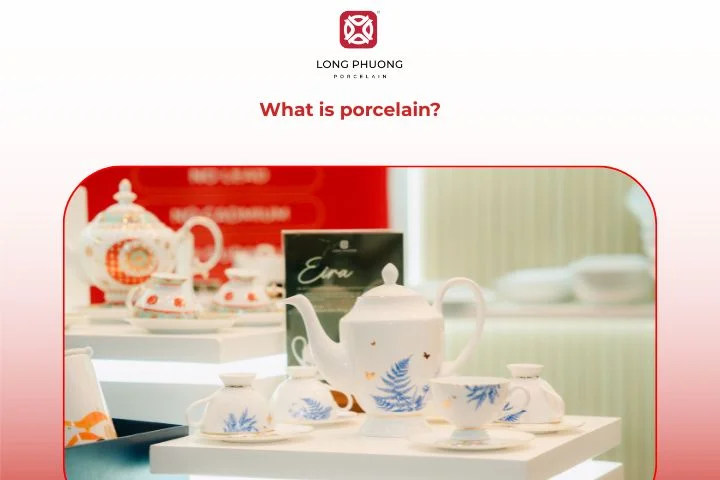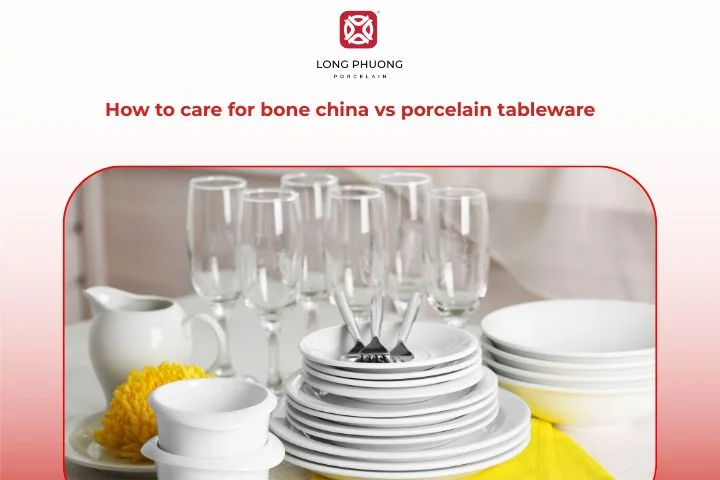When it comes to selecting elegant tableware, the debate between bone china vs porcelain is one that often comes up. Both materials are celebrated for their beauty, durability, and ability to elevate your dining experience. However, subtle differences set them apart, making each suitable for different occasions and preferences. In this guide, we’ll explore everything from the basics of china porcelain to their care, cost, and everyday usability.

1. What is porcelain?
Porcelain, often referred to simply as “china” (in a generic sense), is a ceramic material made from a mixture of clay, kaolin, and other minerals. This mixture is fired at extremely high temperatures, typically between 2,200°F and 2,600°F (1,200°C and 1,400°C). This intense heat vitrifies the clay, making the final product non-porous, incredibly strong, and resistant to stains and chipping.
The history of porcelain dates back to ancient China, where it was first developed over a thousand years ago. Its delicate appearance and remarkable strength made it a highly sought-after material, leading to its name being synonymous with fine dinnerware.
Key characteristics of porcelain:

- Durability: Porcelain is known for its incredible strength and chip resistance. The high firing temperatures create a very hard surface.
- Non-porous: Its non-porous nature means it doesn’t absorb liquids, making it stain-resistant and easy to clean.
- Translucency: While not as translucent as bone china, some high-quality porcelain can have a slight translucency.
- Color: The color is typically a clean, bright white or off-white.
- Weight: It’s generally heavier and thicker than bone china.
Porcelain is a fantastic choice for everyday use and special occasions. Its robustness makes it suitable for frequent washing and handling. Whether it’s a casual family dinner or a formal gathering, porcelain tableware stands the test of time.
2. What is bone china?
Bone china is a specific type of soft-paste porcelain. What makes it unique is its composition. It’s made from a mixture of kaolin clay, feldspathic material, and a significant amount of bone ash, typically 30-50%. The addition of bone ash gives it a milky, soft-white color and remarkable translucency.
The development of bone china is credited to Josiah Spode, an English potter in the late 18th century. He discovered that adding calcined bone ash to his ceramic mixture resulted in a material that was both incredibly strong and beautifully translucent, a combination previously unheard of. This innovation revolutionized the porcelain industry.

Key characteristics of bone china:
- Translucency: This is the most defining feature. When you hold a piece of bone china up to a light, you can often see the shadow of your hand through it. This delicate translucency gives it a refined, elegant look.
- Strength and Durability: Despite its delicate appearance, bone china is surprisingly strong. The bone ash makes it more resilient to chipping than many other ceramic materials.
- Lightweight: It is noticeably lighter and thinner than traditional porcelain, which contributes to its elegant feel.
- Color: Its color is a warm, creamy white, often described as luminous.
- Chip Resistance: While it can still break, its composition makes it less prone to chipping compared to other types of china.
Bone china is often associated with luxury and formal dining. Its elegant aesthetic makes it a favorite for special occasions, fine dining restaurants, and even as heirloom pieces.
See more: Top 10 best bone china dinnerware sets
3. Bone china vs porcelain: Which one is better for your tableware?
Deciding between bone china vs porcelain largely depends on your priorities—whether you value durability, aesthetics, or cost. Here’s a breakdown to help you make an informed choice.
| Feature | Porcelain | Bone China |
| Appearance | Pure white to bluish-white; slightly denser | Creamy-white; high translucency |
| Durability | Strong, less prone to chipping than earthenware | Extremely strong for its thinness, chip-resistant |
| Weight | Slightly heavier than bone china | Lightweight, easy to handle |
| Cost | More affordable | Higher-priced due to luxury status |
| Use | Everyday or formal dining | Best for formal dining or special occasions |
Both bone china vs porcelain sets can last decades with proper care. If you are looking for everyday practicality, porcelain may be more suitable. However, if elegance and presentation are your main priorities, bone china stands out.
4. How to care for bone china vs porcelain tableware

Proper care ensures your tableware maintains its beauty and longevity. While both materials are durable, their unique compositions require slightly different handling.
Caring for Porcelain
- Dishwasher Safe: Most modern porcelain dinnerware is dishwasher safe. However, check the manufacturer’s instructions.
- Microwave Safe: Porcelain is generally microwave safe, but be careful with pieces that have metallic gold or silver rims, as they can spark.
- Hand Washing: For best results, hand washing with a soft sponge and mild detergent is always a safe bet, especially for pieces with delicate patterns.
Caring for Bone China
- Dishwasher Safe: Many manufacturers now produce dishwasher-safe bone china. However, hand washing is highly recommended to preserve the finish, especially for intricate patterns or metallic accents.
- Microwave Safe: Like porcelain, avoid microwaving bone china with metallic decorations. The delicate nature of the material means it can be more susceptible to thermal shock, so it’s best to avoid sudden temperature changes.
- Storage: When stacking bone china plates, place a soft cloth or paper napkin between each one to prevent scratching.
5. FAQ

5.1. Which is better bone china or porcelain?
Neither is definitively “better.” Bone china is prized for its elegance, lightness, and translucency, while porcelain is valued for its sturdiness, practicality, and affordability. The best choice depends on your needs. For everyday use, porcelain is excellent. For a touch of luxury and formal occasions, bone china is the top choice.
5.2. Which is more expensive bone china vs porcelain?
Bone china is almost always more expensive than porcelain. The higher cost is due to the addition of bone ash, which is a more expensive raw material, and the more complex manufacturing process required to achieve its delicate properties.
5.3. Is porcelain or bone china better for everyday use?
For everyday use, porcelain is generally the better option. Its durability, resistance to chipping, and general robustness make it a practical and long-lasting choice for daily meals. Porcelain vs china for daily use often comes down to practicality, and porcelain wins.
5.4. What is the difference between bone china and porcelain mugs?
The difference between bone china and porcelain mugs is the same as with other tableware. A bone china mug will be lighter, thinner, and have a more luminous, milky white color. A porcelain mug will be thicker, heavier, and have a brighter white color. The bone china mug will also be more translucent.
6. Where to buy the best porcelain tableware set for your home?
After weighing the pros and cons of bone china vs porcelain, if you’ve decided that the durable, beautiful, and practical nature of porcelain is right for you, look no further than Long Phuong Porcelain.

At Long Phuong Porcelain, we have been crafting high-quality porcelain products for over two decades. Our collections are known for their exceptional durability, elegant designs, and pure, non-toxic materials. We pride ourselves on creating tableware that is not only beautiful but also safe and long-lasting for you and your family.
Our products are fired at a temperature of 1,380°C, making them incredibly strong, chip-resistant, and non-porous. This ensures your bone china vs porcelain dinnerware will withstand the rigors of daily use, from the microwave to the dishwasher, without losing its luster.
Whether you’re looking for a complete dinner set, individual plates, or elegant serving dishes, you’ll find a wide range of options to suit your taste. Visit the Long Phuong Porcelain website today and discover why our products are the perfect choice for creating lasting memories around the table.
Long Phuong Group Joint Stock Company
- Phone number: (+84) 989 595 866
- Email: export@longphuong.vn
- Factory: Hap Linh Industrial Cluster, Hap Linh, Bac Ninh, Vietnam
- Showroom Ha Noi: 59 Cua Bac, Ba Dinh Ward, Hanoi, Vietnam
- Showroom Ha Noi: 37 Cua Nam, Cua Nam Ward, Hanoi, Vietnam
- Showroom TP. Ho Chi Minh: 127 Le Thi Rieng, Ben Thanh Ward, Ho Chi Minh, Vietnam
Related Posts
CEO of Long Phuong Group Joint Stock Company, with more than 20 years of exploration and research to obtain the best formulas and professional experience, Long Phuong Porcelain has produced more than 400 designs of all kinds of household porcelain, Significant contributions to Vietnam's ceramic industry.
 Vietnam
Vietnam
